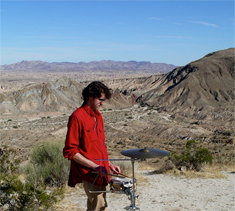
photo by J. Rosenberg
Desert, Forest, Tundra was an experiment and performative artistic work that took place over two and half years and three locations. Desert took place in Carrizo Badlands in the Anza Borrego State Park in California, Feb. 26th, 2006. Forest took place in Sandwich, NH on the property of Jerry Dodge, a family friend, September 30th, 2006. Tundra took place somewhere near the McClaren Lodge in the Denali Plain, central Alaska, June 25-26th, 2008. Desert, Forest, Tundra was at its core about experience.
It was necessary for this entire project to remove concert infrastructure, and subsequently compositional narrative in order to impose such an experience. This is why we performed works like John Luther Adams’ “Strange and Sacred Noise”, and James Tenney’s “Having Never Written a Note.” There is, in my opinion, no narrative material and their physical presence is immense when performed within a concert space.
Why were we there?
Throughout this project there was a strong sense of ritual. We would all arrive to a location, scout out its potential, set-up, perform, tear down and quietly leave. Through this process we all gained an intimate connection to these places and the people. They became special. Art is about making special. If you don’t believe me read Ellen Dissanayake’s “Homo Aestheticus.” I think people had an intrinsic desire to go to these places and be part of something special. Something that will only happen once in places that contain a spiritual presence.
What came out of this project?
For me nothing tangible resulted from this project. It is some of the most significant work I have done. But personally, no fame, no glory, just memories. The extrinsic result of DFT, in my own observation, has however been interesting. I have been told that this experience inspired the work by Adams titled “Inuksuit”, which has remitted a little New Music Media frenzy. But this project has not been specifically cited by name, just mentions of music being played outdoors.
There will be a documentary that shows parts of Tundra, but it is not about the project itself. Moreover, recent concerts that I have been part of were similar in scope but all seemed to lack the specialness that DFT inherited. Most, not all, promoted the extreme nature of “going outside.” But anyone can play music outdoors. In fact music sounds relatively awful outside. It is clear, through many decades of people trying, writing music specifically for the outdoors is daunting.
If you could summarize, what is Desert, Forest, Tundra?
DFT is about making special and making experience. DFT is about letting environment truly surround us, take us hostage. DFT is about ritual and community. DFT is about the people listed below.
Who took part in this project?
There were many people involved with making this project happen, too many in fact to list appropriately. So I must list some institutions to get everyone who deserves credit. Thank you all.
- The Anza-Borrego State Park staff
- John Luther Adams – composer
- Dartmouth College – rehearsal space
- Jerry Dodge – land owner for Forest
- Len Kamerling – documenteur and his team (who are listed in his film)
- Eduardo Leandro – performer/instrument rental Forest (and bush pilot)
- Art Miller – professor UCSD/ co-hosted workshop following Desert
- Morris Palter – performer Tundra
- Doug Perkins – performer Forest, Tundra / instrument rental Forest
- The members of red fish blue fish (Gustavo Aguilar, Justin DeHart, Don Nichols, Fabio Oliveira, Greg Stuart)
- Steven Schick – performer Desert, Forest, Tundra / mentor
- Lisa Tolentino – performer Desert, Forest, Tundra
- University of Alaska, Fairbanks – rehearsal space
- University of California, San Diego Music Dept. and Scripps Institute of Oceanography
- University of Mass., percussion students – performing the Tenney and supporting Forest
All photos by Lisa Tolentino unless noted.